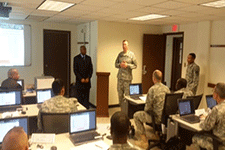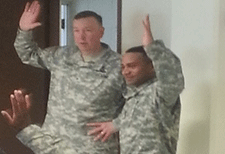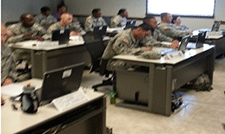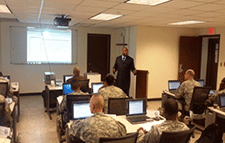
GCSS-Army Conducts New Equipment Training at Camp Henry
As soldiers and Non-Commissioned Officers from Echo Company, 2nd Battalion, 1st ADA of the 35th ADA Brigade settled into class on the first day of GCSS-Army New Equipment Training (NET) they received a little extra motivation from the chain of command. BG Stephen E. Farmen, Commanding General of the 19th Expeditionary Sustainment Command stopped by to speak with the class on the importance of learning the new system and how it will impact certain business areas in the future. He told soldiers they are the key into making Korea successful in the transition from SARSS-1 to GCSS-Army.

BG Stephen E. Farmen CG, 19th ESC addressing soldiers in GCSS-Army Warehouse New Equipment Training
The 19th ESC is the largest forward-deployed multi-component ESC in the U.S. Army. It is headquartered in Daegu, South Korea and provides logistical support to the Eighth United States Army. The 19th ESC also assists and coordinates the collective efforts of individual subordinate commands and units located throughout the Republic of Korea. The Command Reserve Components remain at the ready to deploy during contingency situations and are located in Des Moines, Iowa. Collectively, the 19th ESC comprises a team of professionals to support the 37,000 U.S. troops stationed in the Republic of Korea. 19th ESC supports maintaining the Armistice and deterrence of North Korean aggression against the Republic of Korea (ROK).
Should deterrence fail, the 19th ESC supports Noncombatant Evacuation Operations; transitions to wartime posture; conducts Reception, Staging and supports Onward movement of deploying US forces; and performs Army Support to Other Services (ASOS) in support of operations on the Korean peninsula. On order the 19th ESC conducts redeployment operations.
Robert J. VazquezFigueroa, Chief of Installation for PM GCSS-Army stated, “Having a Commanding General visit us on the first day of classroom instruction is a testament of the strong commitment from the 19 ESC leadership to make GCSS-Army implementation a success. BG Farmen is fully aware of the many benefits that GCSS-Army brings to the 19 ESC, 8th Army and the Korean Area of Operation, and he is confident that the investment it will pay off by improving readiness, visibility and accountability to the Total Army.”

BG Stephen E. Farmen CG , 19th ESC and PFC Jorge Figueroa 2-1 ADA
While it is rare in the Army for a Private First Class (PFC) to have an occasion to brief a General Officer, the opportunity did present itself for PFC Jorge Figueroa. PFC Figueroa, a 92A Automated Logistics Specialist who works in the Supply Support Activity, briefed BG Farmen on what he had learned in class thus far and continued to offer his insight on system benefits and how he foresees GCSS-Army working in the future.
The mission of the 2-1 ADA “Guardian Battalion” is to conduct Theater Air and Missile Defense (TAMD) operations at the specific DALs in the KTO-N AOR in order to deter, then defeat North Korean (nK) Tactical Ballistic Missile (TBM) attacks.
The 2nd Battalion, 1st Air Defense Artillery Regiment has a long and storied history. Formed during the War of 1812 and originally designated as Ichabod B. Crane's Company in the 3rd Regiment of Artillery, the unit participated in a variety of conflicts throughout the early history of the United States, to include campaigns against the Seminoles, the Texas Indian Uprising of 1859 and various battles of the Mexican-American War. During the American Civil War, the Company participated in the first engagement of the war at Fort Sumter and went on to participate in twenty-four campaigns to include: First Bull Run, Second Bull Run, Antietam, Fredericksburg, Chancellorsville, Gettysburg, and the Peninsula campaign. The artillery company was also present at Lee's surrender at Appomattox, thus participating in the last shots fired of the Civil War as well. Throughout the 20th century, the Battalion went through a series of re-designations as it fought in various conflicts, including the Great War, World War II and Operation Desert Shield/Desert Storm.

Soldiers from 2-1 ADA attending GCSS-Army Warehouse NET
Throughout this period the Battalion's capabilities changed and evolved from tube artillery, to the Nike Hercules Missile System, to the Hawk Missile System, and culminating in the Patriot Missile System that we use today. In June 2001 the Battalion completed its first rotation to Southwest Asia in support of Operation Southern Watch. A year later in October 2002, it deployed to Kuwait in support of Operation Enduring Freedom and Operation Iraqi Freedom, returning to Fort Bliss in May 2003. One year later, the Battalion received orders to deploy to the Korean Theater of Operations with the 35th ADA Brigade Headquarters in order to augment Theater Air and Missile Defense of Combined Forces Command critical assets.

- Mr. Kendell Smith, Warehouse Instructor for GCSS-Army, provides training to 2/1 Air Defense Artillery and selected personnel from 19 ESC.
After much hard work, the Battalion established operations at Gwangju Air Base, culminating in mission assumption on December 6th, 2004. The Battalion has since moved from Gwangju Air Base to Camp Carroll, Korea. Under the current leadership, the 2-1 ADA Battalion has completed a Brigade Command Inspection, multiple deployments to wartime locations, two Relief-in-Place operations, and an intensive Battalion External Evaluation. The Soldiers of 2-1 ADA have proudly and tenaciously provided assigned critical assets with continuous defense against the threat of tactical ballistic missiles every hour of every day. True to its motto, this Battalion performs “Second to None."